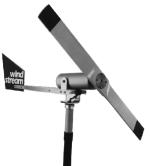Search engine visitors - click here to access entire "$ensible Home" web site
Click here to see a descriptive illustration of the components of a typical windmill system.
Dear Jim: It seems like the area where I live is fairly windy. I have always liked the idea of generating my own electricity with a small windmill. What types of systems are available for home use? - Pete O.

A: There is a huge array of windmill sizes ranging from tiny portable 13-pound models to large ones that can satisfy the electricity needs of an entire house. If your windmill produces more power than you are using at that instant, many utility companies will buy the extra electricity from you.
The payback you get from installing a windmill depends on the average wind speed in your area and your local electric rates. In many cases, the payback period is long. The reasons for installing a windmill often are for a backup power source or just a desire to protect the environment.
An excellent use for tiny, lightweight ones is to keep emergency batteries charged or to provide electricity for cabins, outdoor workshops, boats, and RV's. The electricity output ranges from about 150 to 500 watts, easily enough power to keep a wood pellet stove operating during a power outage.
For any of the above applications, a combination of a small windmill and a solar panel is effective. When it is sunny and calm, the solar panels make electricity. When it is cloudy and stormy, the windmill carries the load.
A large whole-house windmill often produces 8,000 to 12,000 watts of electricity and has a blade diameter of 20 feet or more. Some designs begin producing electricity at a wind speed as low as 8 m.p.h., but an average speed of 10 to 11 m.p.h. is typically needed to make one more economically feasible.
Even if you install a large, whole-house-sized windmill, you should still keep your house attached to the utility company's wires (power grid). Sophisticated electronics inside the windmill controller match the electricity output to that of the utility company so they are compatible.
There are typically two ways the electric utility company will compensate you for excess electricity your windmill produces. Under "net billing," your electric meter just runs in reverse. Another common method uses a second electric meter and the utility company pays you for the extra power.
In addition to charging batteries, another method of storing the wind's energy is to wire the windmill directly to a heating element in a large water heater tank. The electricity from the windmill keeps the water hot.
The high, very large windmills require a substantial structure for support, but the small models are easy to install. A 1.5-inch-diameter steel pipe is adequate support. The windmill should be about 10 feet higher than any nearby obstructions.
Instant Download Update Bulletin No. 485 - buyer's guide of 10 portable and whole-house windmills, rated power output, voltage output, sizes (includes weight, number of blades and rotor diameter), start up wind speed, rated wind speed, features, prices and a wind speed chart for 116 cities. Specifications and information are listed for selected models and siting and tower recommendations.
Dear Jim: Whenever I take a shower, some water continues to flow out of the spout below and the shower does not feel as forceful as it used to. Is this normal or should I have the spout and shower valve repaired? - Dawn R.
A: A little trickle of water from the bathtub spout is typical, but a substantial flow is unusual. Since you noticed the force of the shower is not as great as before, you should repair the valve.
This problem not only causes a weak shower flow, but it also wastes water and energy. If the shower flow is weak and slow, the water droplets tend to cool before they hit your body so you have to adjust the water temperature even higher.